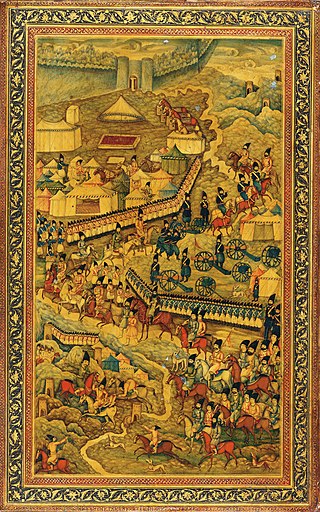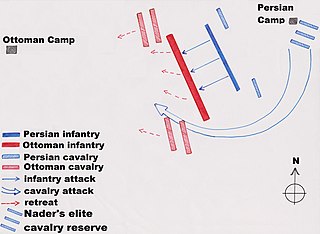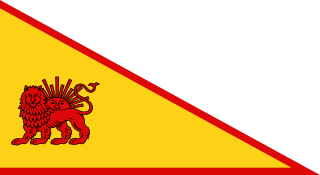
Ahmad Shāh Durrānī, also known as Ahmad Shāh Abdālī, was the founder of the Durrani Empire and is often regarded as the founder of modern Afghanistan. In June 1747, he was appointed as King of the Afghans by a loya jirga in Kandahar, where he set up his capital.

The Third Battle of Panipat took place on 14 January 1761 between the Maratha Confederacy and the invading army of the Durrani Empire. The battle took place in and around the city of Panipat, approximately 97 kilometres (60 mi) north of Delhi. The Afghans were supported by three key allies in India: Najib ad-Dawlah who persuaded the support of the Rohilla chiefs, elements of the declining Mughal Empire, and most prized the Oudh State under Shuja-ud-Daula. The Maratha army was led by Sadashivrao Bhau, who was third-highest authority of the Maratha Confederacy after the Chhatrapati and the Peshwa. The bulk of the Maratha army was stationed in the Deccan Plateau with the Peshwa.

The Battle of Karnal was a decisive victory for Nader Shah, the founder of the Afsharid dynasty of Iran, during his invasion of India. Nader's forces defeated the army of Muhammad Shah within three hours, paving the way for the Iranian sack of Delhi. The engagement is considered the crowning jewel in Nader's military career as well as a tactical masterpiece. The battle took place near Karnal in Haryana, 110 kilometres (68 mi) north of Delhi, India.

Shahrokh Mirza, better known by his dynastic title of Shahrokh Shah was the Afsharid king (shah) of the western part of Khorasan from 1748 to 1796, with a two-month interruption. A grandson of the Iranian conqueror Nader Shah, Shahrokh was the son of Reza Qoli Mirza Afshar and his Safavid wife Fatemeh Soltan Begom, who was the sister of Tahmasp II, the penultimate Safavid shah of Iran. Shahrokh's half-Safavid descent made him stand out amongst his Afsharid relatives, and was used to bolster the legitimacy of his grandfather. After the assassination of Nader Shah in 1747, his nephew Ali-qoli Khan, ascended the throne in Mashhad and had all of Nader Shah's descendants in fortress of Kalat massacred. Shahrokh was spared in case his Safavid lineage would come to use, and was instead kept in the fortress as a prisoner. While Adel Shah was battling his rebellious younger brother Ebrahim Mirza, a party of Turkic, Kurdish, and Arab tribal leaders took advantage of his absence and installed Shahrokh on the throne. Both Adel Shah and Ebrahim were eventually defeated and killed, but Shahrokh was not long afterwards overthrown by a party of dissident tribal leaders, who installed the Safavid pretender Mir Sayyed Mohammad on the throne. Shahrokh was soon blinded at the instigation of Mir Alam Khan Khuzayma and other leading nobles, much against Suleiman II's will.

The Hotak dynasty was an Afghan monarchy founded by Ghilji Pashtuns that briefly ruled portions of Iran and Afghanistan during the 1720s. It was established in April 1709 by Mirwais Hotak, who led a successful rebellion against the declining Persian Safavid empire in the region of Loy Kandahar in what is now southern Afghanistan.

The Battle of Damghan or Battle of Mehmandoost was fought on September 29 to October 5, 1729, near the city of Damghan. It resulted in an overwhelming victory for Nader Shah and the Safavid cause he had taken up, though by itself it did not end Ashraf's rule in Iran, it was a significant triumph which led to further successes in the following engagements of the campaign to restore Tahmasp II to the throne. The battle was followed by another one in Murcheh-Khort, a village near Isfahan. Nader's forces were victorious in both battles, which led him to remove the Ghilzai Afghan dynasty from their short stay on the Persian throne. The Hotakis were forced back to their territory in what is now southern Afghanistan.

The siege of Kandahar began when Nader Shah's Afsharid army invaded southern Afghanistan to topple the last Hotaki stronghold of Loy Kandahar, which was held by Hussain Hotaki. It took place in the Old Kandahar area of the modern city of Kandahar in Afghanistan and lasted until March 24, 1738, when the Hotaki Afghans were defeated by the Persian army.

The campaigns of Nader Shah, or the Naderian Wars, were a series of conflicts fought in the early to mid-eighteenth century throughout Central Eurasia primarily by the Iranian conqueror Nader Shah. His campaigns originated from the overthrow of the Iranian Safavid dynasty by the Hotaki Afghans. In the ensuing collapse and fragmentation of the empire after the capture of the Iranian capital of Isfahan by the Afghans, a claimant to the Safavid throne, Tahmasp II, accepted Nader into his service. After having subdued north-west Iran as well as neutralising the Abdali Afghans to the east and turning Tahmasp II into a vassal, Nader marched against the Hotaki Afghans in occupation of the rest of the country. In a series of incredible victories the Afghans were decimated and Tahmasp II returned to the throne as a restored Safavid monarch.

The First Herat War was an attack on the Principality of Herat by Qajar Iran during the Great Game. Herat was held by Kamran Shah and his vizier Yar Mohammad Khan Alakozai. The Shah of Persia was Mohammed Shah Qajar. Four Europeans were involved: the British, Sir John McNeill and Eldred Pottinger as well as the Russians, Count Simonich and Jan Prosper Witkiewicz. Sher Mohammad Khan Hazara, an ally of Kamran and chieftain of the Qala-e Naw Hazaras, helped form a Sunni confederacy of Aimaq, Turkmen, and Uzbek tribes and played a crucial role in defending Herat when the city was besieged. The siege ended when neither side gained a clear advantage, the British threatened to take military action and the Russians withdrew their support.
The Battle of Sangan, was an engagement involving the Loyalist forces of Tahmasp II of Safavid Iran led by Nader and the Abdali Afghan tribes in and further beyond southern Khorasan in the autumn of 1727. This armed struggle was one of the initial battles between the resurgent Safavid cause and that of the Afghans. The engagement technically ended in a Safavid victory.

|strength1= Unknown |strength2= Unknown |casualties1= Minimal |casualties2= Minimal

The Campaign of Herat consisted of a series of intermittent and fluid engagements culminating in the finale of Nader's military operations against the Abdali Pashtuns. Nader having recently concluded a successful campaign against his own monarch and prince, the badly humiliated Tahmasp II, set out from Mashad on 4 May 1729, making sure that the Shah also accompanied him on this journey where he could be kept under close supervision.

The Battle of Murche-Khort was the last decisive engagement of Nader's campaign to restore Tahmasp II to the Persian throne. Ashraf Hotak had failed to arrest Nader's advance onto Isfahan at Khwar pass where his ambush was discovered, surrounded and ambushed itself. The battle was fought in an uncharacteristic manner by the Afghans who to some extent sought to replicate their foes tactical systems which had so badly devastated their armies up to this point. Victory opened a clear road south towards Isfahan and the return of Safavid rule for a few brief years before Nader himself would overthrow it.

The campaign of 1731 was a failed attempt by Tahmasp II of the Safavid dynasty to launch an offensive into Ottoman held Caucasus which ended in a disastrous defeat with all of Nader's gains during the previous year being lost. The result of this particular military catastrophe was still overturned with Nader's return from the east but would have much more significant impact on the Safavid dynasty itself as Tahmasp II sealed his own fate by initiating this ill fated expedition.

The Herat Campaign of 1731 took place when Nader Shah who had already successfully driven the Ottomans from western Iran and southern Azerbaijan had to cut his campaign short to deal with the revolt of the Abdalis of Herat who were provoked into bearing arms against their Persian overlords by Hussein Hotaki of Qandahar. The conflict resulted in the re-establishment of Persian rule over Herat.

The Battle of Kars was the last major engagement of the Ottoman-Persian War. The battle resulted in the complete and utter destruction of the Ottoman army. It was also the last of the great military triumphs of Nader Shah. The battle was in fact fought over a period of ten days in which the first day saw the Ottomans routed from the field, followed by a series of subsequent blockades and pursuits until the final destruction of the Ottoman army. The severity of the defeat, in conjunction with another defeat near Mosul, ended any hopes of Ottoman victory and forced them to enter into negotiations with a significantly weaker position than they would otherwise have occupied.

The military forces of the Afsharid dynasty of Iran had their origins in the relatively obscure yet bloody inter-factional violence in Khorasan during the collapse of the Safavid state. The small band of warriors under local warlord Nader Qoli of the Turkoman Afshar tribe in north-east Iran were no more than a few hundred men. Yet at the height of Nader's power as the king of kings, Shahanshah, he commanded an army of 375,000 fighting men which, according to Axworthy, constituted the single most powerful military force of its time, led by one of the most talented and successful military leaders of history.

After the succession of setbacks the Abdalis of Herat had faced in the campaign Allahyar Khan decided to sully out for a last engagement to decide the issue. Unfortunately yet again the charge of the Afghan horsemen was broken up by the disciplined fire of the Persian line musketeers and flank attacks by the supporting Persian cavalry. Allahyar Khan was left no choice but to withdraw his battered army behind the walls of Herat in the hopes of withstanding the coming siege. An intense bombardment of the city ensued with heavy cannon and mortars battering the city's defences. After consulting with his advisers Allahyar Khan was convinced of the futility of further resistance. Peace terms were offered and the Abdalis agreed to sear fealty to Tahmasp II as the rightful ruler of Persia and Herat. Thus the Abdalis were brought under Persian suzerainty.

The Guarded Domains of Iran, commonly referred to as Afsharid Iran or the Afsharid Empire, was an Iranian empire established by the Turkoman Afshar tribe in Iran's north-eastern province of Khorasan, establishing the Afsharid dynasty that would rule over Iran during the mid-eighteenth century. The dynasty's founder, Nader Shah, was a successful military commander who deposed the last member of the Safavid dynasty in 1736, and proclaimed himself Shah.

The Second Herat War was the invasion of the surrounding realm of Herat and the successful siege of its citadel by the Qajar army led by Hesam o-Saltaneh, Soltan Morad Mirza. The 1856 siege was part of the concerted Qajar effort to compensate the recent territorial losses in the Russo-Persian Wars of 1804–1813 and 1826–1828 by reconquering western Afghanistan, which had historically been a part of Persia's domain. The conflict was also a part of the broader Great Game between the British Empire and the Russian Empire.




















